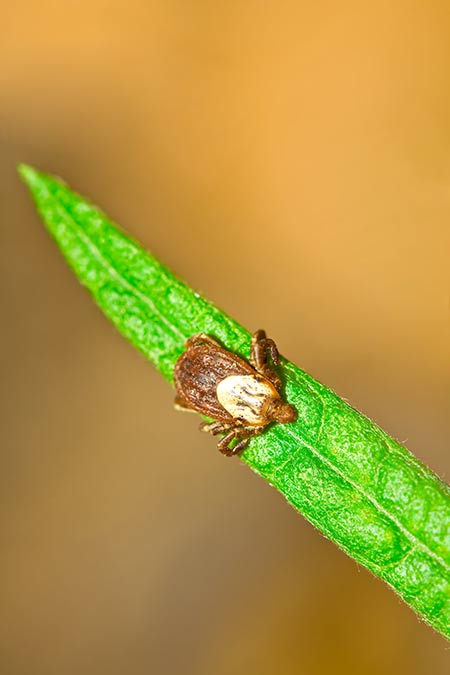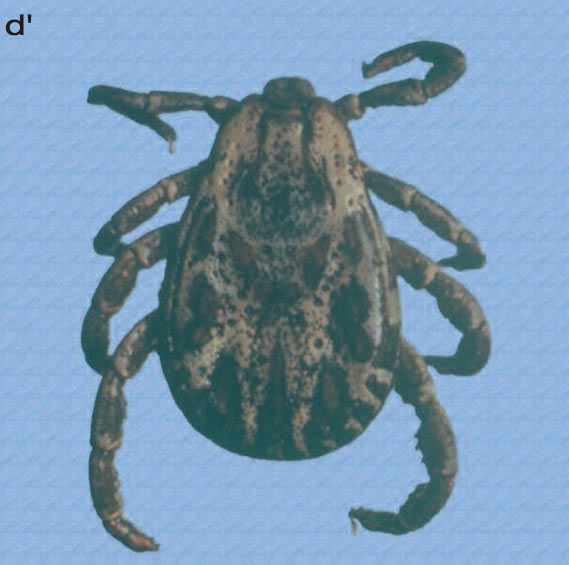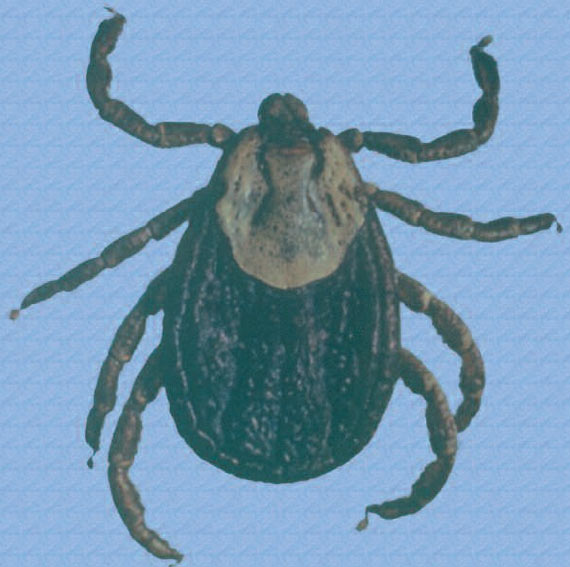Rocky Mountain Wood Tick
 INTRODUCTION
INTRODUCTION
The common name comes from its primary distribution being in the Rocky Mountain states and the preferred habitat being the woods to meadow/lawn transition zone. Although not a structural pest, the Rocky Mountain wood tick is the primary vector of Rocky Mountain spotted fever and also transmits the casual organisms of Colorado tick fever and tularemia; it also causes tick paralysis. This tick occurs primarily in the Rocky Mountain states and adjoining southern Canada.
 RECOGNITION
RECOGNITION
Unengorged adult female about 1/8″ (2.8-5.4 mm), male about 1/16-1/4″ (2.1-6.1 mm); engorged female up to about 5/8″ (16.5 mm) long, 1/2″ (11.4 mm) wide. Body oval, dorsoventrally flattened (top to bottom). Color brown, becoming grayish when engorged; scutum (dorsal shield) almost completely gray in female, mottled brown and gray in male. Scutum (dorsal shield just behind mouthparts) restricted to front half of dorsum in female, almost completely covering dorsum in male except for festoons. Eyes on margin of scutum. Capitulum (mouthparts and their base) visible from above; basis capituli (base for mouthparts) rectangular with  sides not laterally produced/ angular, about as long as mouthparts; 2nd segment of palpi about as long as wide, not laterally produced. Abdominal festoons (rectangular areas divided by grooves along posterior margin) 11 in number; anal groove present, posterior to anus. Spiracular plate (ventral/bottom, near margin just behind 4th coxae, 1 pair) broad, with blunt process usually reaching dorsum, goblets (round structures) moderate in size and number.
sides not laterally produced/ angular, about as long as mouthparts; 2nd segment of palpi about as long as wide, not laterally produced. Abdominal festoons (rectangular areas divided by grooves along posterior margin) 11 in number; anal groove present, posterior to anus. Spiracular plate (ventral/bottom, near margin just behind 4th coxae, 1 pair) broad, with blunt process usually reaching dorsum, goblets (round structures) moderate in size and number.
Unengorged 1st instar larvae about 1/64″ (0.6 mm) long, with 6 legs; 2nd instar nymphs about 1/16″ (1.4-1.5 mm) long, with 8 legs.
SIMILAR GROUPS
(1) American dog tick (Dermacentor variabilis) with spiracular plate goblets (round structures) very small and numerous, not found in Rocky Mountain area.
(2) Winter tick (Dermacentor albipictus) and brown winter tick (Dermacentor nigrolineatus) with spiracular plate oval, lacking prolongation, and goblets few and large; in addition, brown winter tick scutum (dorsal shield just behind mouthparts) with little or no whitish/grayish markings.
(3) Pacific Coast tick (Dermacentor occidentalis) with posterior/rear lateral extensions of basis capituli (base for mouthparts) long, length equal to or greater than width.
(4) Tropical horse tick (Anocentor nitens) with 7 abdominal festoons (rectangular areas divided by grooves along posterior margin) and hypostome (middle mouthpart) with denticles (teeth or venter) in 8 rows (vs. 6 rows for Dermacentor spp.).
BIOLOGY
The engorged female drops off the host and seeks a sheltered place to lay her eggs. After a preoviposition or waiting period of 3-11 days, she lays an egg mass averaging about 3,000-5,500 eggs (range 2,500-7,396) over 10-33 days, and then dies in 1-14 days. Egg hatch occurs in 7-38 days depending on the temperature (90°F/32°C- 72°F/22°C respectively). Larvae (6-legged) attach to hosts which happen by but usually die in 30 days if not successful; can survive up to 117 days unfed. They usually feed for 3 days (range 2-8 days) to engorgement, and drop to the ground. They molt to nymphs (8- legged) in 6-21 days and may survive 300+ days unfed. After finding a suitable host, nymphs reach engorgement in 3-11 days, drop off, and molt into adults in 14-15 days (range 12-120 days). Adults can survive more than a year (about 600 days) unfed but after finding a suitable host, adults mate on the host after partial feeding. Engorgement of the female requires 4-17 days and she then drops off. Under optimal conditions the life cycle (egg to egg) may be completed in 68 days in the laboratory, but requires 1-3 years outdoors depending on host availability.
Nymphs and adults overwinter in ground debris. They become active with the first warm days of spring and attach to passing hosts. They feed only from mid-March until mid-July and, therefore, this is the only period when humans can contract the diseases this tick vectors.
Rocky Mountain wood ticks are the primary vector of Rocky Mountain spotted fever which they transmit from small animals, primarily rodents. This is a severe, acute, infectious disease of the small peripheral blood vessels caused by the rickettsial bacterium (Rickettsia rickettsii) whose characteristic symptom is a rash which develops in 2-5 days, starting with the wrists and ankles and then spreads over the body. Mortality in humans is 20% or more. Fortunately, attachment for 2 hours or more is required for transmission.
These ticks are also vectors for Colorado tick fever that is caused by a virus (Coltivirus sp.) which is a viral disease of short duration and low mortality. It is characterized by sudden onset, saddleback fever (fever disappears in 1-3 days in middle of illness only to return), headache, muscular pain, reduction of white corpuscles in blood, and absence of a rash. It is more common in adult males, but also occurs in women and children. The wild reservoir is small rodents, particularly ground squirrels. This disease occurs in the Rocky Mountain states at elevations of 4,000 to 10,500 feet (1,219.2-3,200.4 m).
Rocky Mountain wood ticks also transmit tularemia, which is caused by the bacterium Francisella tularensis that is transmitted primarily from rabbits and rodents. Symptoms include chills and fever, prostration, an ulcer at the tick bite site, and tender, swollen lymph nodes.
In addition, these ticks can cause tick paralysis when they feed for at least 5-6 days. Paralytic symptoms usually start in the extremities and become evident as unsteadiness and loss of reflex actions. If the tick is not removed, death may result from respiratory failure; children are particularly susceptible. If the tick is removed recovery is rapid, usually within 24-72 hours.
HABITS
Rocky Mountain wood ticks do not survive well indoors. If found indoors, it was probably carried in on a pet or humans and dropped off when fully engorged.
This is a 3-host tick, with each stage requiring a different host. These ticks typically crawl up on low vegetation and wait for a host to pass. Larvae and nymphs feed mainly on rodents such as chipmunks and ground squirrels. Adults are active on the ground during sunny days, climbing up and down vegetation along large animal trails; this means that not all adults will be caught on a tick drag. Adults prefer large animal hosts such as cattle, sheep, deer, humans, etc.
Adult females insert their mouthparts into the host and feed until fully engorged. However, males have a cycle of feeding for a short time, withdrawing their mouthparts, hunting for a female and mating, and then going back to feeding. Adults usually appear in late February and are gone by July, with unfed adults aestivating and then overwintering. Larvae feed throughout the summer. Nymphs may continue to be present until late summer. Engorged larvae and nymphs as well as unfed adults can overwinter.
CONTROL
Reducing the likelihood of being fed upon by Rocky Mountain wood ticks can be separated into 4 considerations.
Personal protection. Keep trouser legs tucked into socks or boots, shirts tucked in, and clothes buttoned. Avoid sitting on logs, stumps, or the ground in brushy areas. Periodically inspect clothing and the body for ticks to remove them before they become attached. If a tick is found attached, remove it with a slow steady pull that will not break off the mouthparts and leave them in the skin. It is best to use forceps whose tips are placed on or just behind the mouthparts. If fingers are used, place the fingernails of thumb and index finger on or just behind the mouthparts but be sure to wash thoroughly with soap and water afterwards. Be sure to clean the attachment area. Liberal use of tick repellents is helpful, including application to clothing.Habitat modification. Keep the grass cut to 3″ (7.5 cm) or less; this also reduces rodent habitat. Trim back vegetation along trails, paths, and yard edges. Remove debris and ground cover to discourage rodents.Removal of hosts. The reduction or elimination of rodents in the area immediately surrounding the house is helpful. This can be done by the use of rodenticides and/or traps.Pesticide application. In heavily infested areas the application of an appropriately labeled pesticide may be advisable. Concentrate on the areas most likely to harbor ticks such as along paths, trails, and roads, and the yard-woods interface. The 1st application should be in the early spring to reduce the larvae and nymphs which overwintered.

